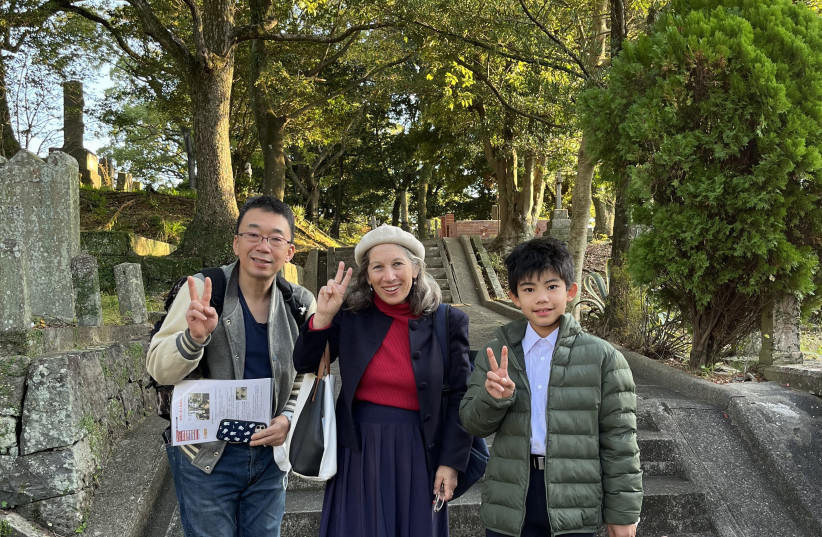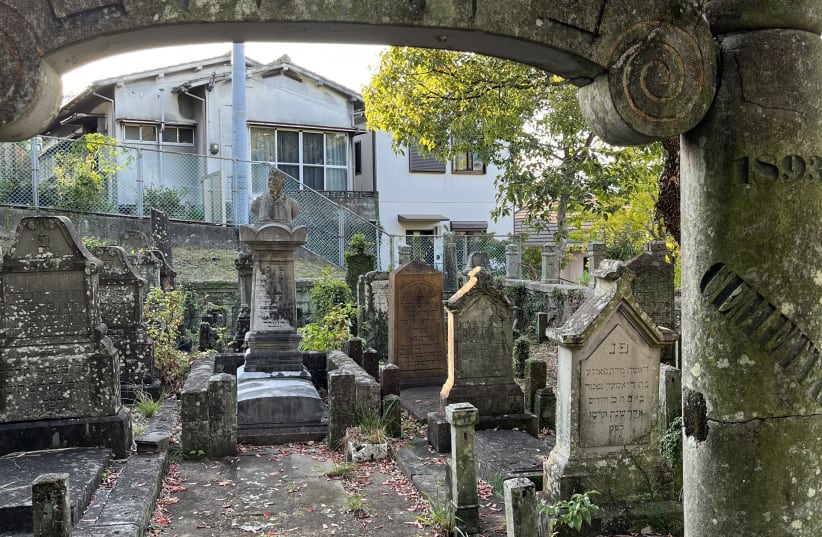Among anniversaries of historical Jewish importance, the centennial of the demise of Japan’s first synagogue is one that even the Jews of Japan may be pardoned for not knowing about.
But as we ring out 2022, marking 100 years since the closure of Nagasaki’s briefly thriving Jewish community, its peaceful cemetery is still standing and proof of how remarkably Jews have survived throughout time – by moving on when the going gets rough.
When I first heard about the Jewish cemetery in Nagasaki, I was still deeply entrenched in Jewish life in Tokyo, where I had lived for 30 years, closely connected to both the well-established Jewish Community Center, founded in 1951, and two Chabad Houses that had opened in 2000.
What stirred my interest was stumbling upon a book of fascinating Inquisition-era history called The Jewish Pirates of the Caribbean by Edward Kritzler. The book set off bells as I learned that Converso Jews fleeing the Spanish Inquisition had become key players, first in Portugal and then in Holland – from ship navigators to global commodity traders – visiting, if not settling, in major ports around the world.
Nagasaki has a unique foreign history, unlike anywhere else in Japan. It was discovered by the Portuguese in 1543; some 20 years later, they were permitted to trade from an artificial strip of the harbor-side island called Dejima.


Wouldn’t it be something if it could be proven that among the first Portuguese to land in Japan were Jews? The Nagasaki Foreign Cemetery would be a good place to start. And on a recent trip to Japan this past November, I went to Nagasaki to find out.
I was assisted in my research by Chabad Rabbi Binyomin Edery of Tokyo. Today, Jews from every part of the globe are scattered throughout Japan, with hundreds centered in each of the big cities of Tokyo, Kyoto and Kobe, where thriving Chabad Houses are located.
Edery has visited the Nagasaki Jewish cemetery, a separate section of the Nagasaki Foreign Cemetery – even bringing a minyan to say Kaddish.
Part of the Nagasaki Foreign Cemetery is embedded in a sleepy hillside community of modest houses facing the harbor. This leafy Jewish cemetery is set off from the non-Jewish graves by high walls and an arched entryway. Edery had told me that there were approximately 30 gravestones engraved with Hebrew names and burial dates ranging from 1880 to 1920.
The surprise of seeing these Hebrew inscriptions was not mine alone. Standing at the entrance to the Jewish cemetery were nine-year-old Kotaro Takeda and his father, Takashi – Nagasaki locals from the neighborhood who had come here on a class assignment to find out about the Jewish people buried in their midst. It was comforting that this forlorn cemetery mattered to locals.
Nagasaki has more recently built an impressive state-of-the-art museum dedicated to its foreign history when Japan’s only contact with the outside world – from the mid-17th to mid-19th centuries – came via a small contingency of Dutch traders and professionals who were permitted to live on the man-made Dejima island. Much more is known about the distinctive Glover family, whose garden hillside estate is a major tourist attraction in Nagasaki.
Prof. Meron Medzini, a leading scholar on Japanese history and Israel-Japan relations, has found that among the most prosperous Jewish families was 19th-century Russian-born Morris Ginzburg, who escaped tsarist Russia to avoid conscription in the army. Ginzburg helped the Russian government obtain Japanese coal for the Russian East Asian fleet, anchored off Nagasaki in the winter until the Russo-Japanese War of 1904 broke out.
The Ginzburgs were forced to close their business and leave town. Russians continued to run taverns and inns near the harbors, and their numbers were said to increase after the 1917 Bolshevik Revolution, although by this time Nagasaki’s influence as a leading port was on the wane. Refugees preferred to settle in Yokohama or Kobe, where there were more economic opportunities.
MORE RECENTLY, Nagasaki’s rich Jewish life has been explored extensively by Brian Burke-Gaffney, a Nagasaki longtime resident and author of The Nagasaki Foreign Settlement: People, Places and Stories, with Lane R. Earns. He discovered that in its heyday, about 100 Jews lived in Nagasaki. In addition to a cemetery and Japan’s first Beit Israel Synagogue, a Jewish Benevolent Association was established in 1901, an Anglo-Jewish Association in 1902, and fancy dress balls were held in 1907 and 1908.
“We were motivated by a deep curiosity about fellow Westerners who lived in Nagasaki during the foreign settlement period and made various contributions to local culture and industry, and a sense of responsibility to take up the stories that have been neglected by Japanese scholars for various reasons (language barriers, difficulty in accessing sources, indifference, etc.).”
Brian Burke-Gaffney
“We were motivated by a deep curiosity about fellow Westerners who lived in Nagasaki during the foreign settlement period and made various contributions to local culture and industry, and a sense of responsibility to take up the stories that have been neglected by Japanese scholars for various reasons (language barriers, difficulty in accessing sources, indifference, etc.),” writes Burke-Gaffney.
“We delved into various sources, including consular archives, English and Japanese newspapers, related books and dissertations, and information from descendants. The international cemeteries provide a particularly compelling foothold because they are intact.”
Among those buried in the Nagasaki Jewish Cemetery between 1880 and 1920, Burke-Gaffney notes, are a Jewish physician, A.S. Newman, who had practiced in Nagasaki; and Sigmund and Sophie Lessner, founding pillars of the Nagasaki synagogue. With Sigmund’s passing in 1920 and his wife’s three years later, there were so few Jews remaining in Nagasaki that some ex-residents living in Shanghai were authorized to dispose of the Beth Israel Synagogue by auctioning the property.
There are at least two versions of its demise. One is that the old building was used as a warehouse until it was torn down in the 1960s. The other is that it was destroyed by the 1945 nuclear bomb.
As for any proof of Jewish graves from the 1600s, that has yet to be discovered and perhaps will never be found.
This history, nonetheless, is extraordinary, Edery agreed, but the imminent work he said is to restore the cemetery. With his distinctive Borsalino hat, long beard, and long black coat, Edery has been a head-turning presence in Japan for 23 years.
He learned of the extinct Jewish community of Nagasaki serendipitously. Not long after he and his wife, Efrat, arrived in Tokyo, he was standing on a street corner in one of the busiest markets of Tokyo, flanked by neat rows of souvenir stalls lining the approach to the famous Asakusa Kannon Buddhist temple, a must-see in every Japan guidebook.
It was here that Edery came to find – and still seeks – Jews to put on tefillin. In 2001, a Japanese man, Mr. Sakamoto, noticed the rabbi from his car. Sakamoto pulled over, opened his car window, and asked the rabbi if he needed a ride. In Tokyo, known for its marvelous transportation system with a train stop every few blocks, this was an odd and highly unnecessary offer indeed. But Edery got into the car.
“All of a sudden, Sakamoto-san showed me a magazine about Jews that he was reading,” Edery recalled. “He said, ‘Let’s speak in the lobby of a hotel nearby,’ which he owned.
“While we sat in his hotel, he asked me what I was doing in Asakusa. I told him that I was looking to rent a house in the Asakusa area of Tokyo. I was working there, putting tefillin on Jewish tourists 10 to 20 times a day.
“Sakamoto had something he wanted to tell me. His parents were from Nagasaki, and there is a Jewish cemetery on the land that they own. He told me he has Russian blood. I could see that his eyes were big, not typically Japanese.”
Soon thereafter, Edery made the 15-hour drive to Nagasaki to see the Foreign Cemetery, where he found a small sectioned-off area containing a few dozen headstones inscribed in Hebrew.
“Of course, I went to the Nagasaki city office and found out that it’s true – the Gaijin Bochi, which means ‘foreign cemetery’ for Jews and non-Jews, belongs to the Sakamoto family. Then I started to understand this is not a joke,” he said
Shining a light on Jewish Nagasaki
The Nagasaki Jewish community arose out of a historic treaty with US naval commander Commodore Mathew C. Perry in 1853. This led to five Japanese port cities, including Nagasaki and Yokohama, to be opened for foreign trade and foreign settlement, according to Prof. Meron Medzini (emeritus), an expert on East Asian history at the Hebrew University of Jerusalem.
Medzini is the author of Under the Shadow of the Rising Sun, which documents daily life for Jews in pre-war Japan. In 1964, he was the first teacher of modern Japanese history.
“The Jews were not integrated into Japanese society. They remained isolated. They did not intermarry. They didn’t speak the language,” he said in an interview at his home in Jerusalem. “They made their fortune trading with Russia. Most ran hotels and taverns and dealt with Russian sailors, the Pacific fleet, which was based in Vladivostok. Some were sent down to Nagasaki.” Could the earliest Portuguese who landed there have been Conversos (hidden Jews) who were fleeing the Inquisition? To answer that, Medzini cited his book, which offers a sweeping view of foreign relationships with Japan from the 1600s through post-World War II.He noted two Conversos who went to Japan in the 16th century. Mendes Pinto, a trader, arrived in 1537 and then proceeded to write a book that became a major source of knowledge in his day about Japan. Dr. Luis de Almeida, an assumed Converso, (1525-1583), was reported to have built the first European-style hospital in Japan and also to have written a memoir.
Although there have been historical references to both memoirs, neither has been found. Nor have the Conversos’ graves in Japan. At least not yet.
The writer is the author of The Wagamama Bride, a memoir that covers the changing world of Jewish life in Japan between 1987 and 2017, when she was raising a family, working as a journalist and artist in Tokyo, and returning to her Jewish roots. www.goshenbooks.com.
